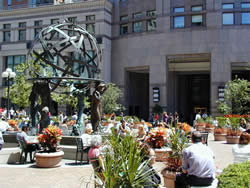Difference between Plaza and Square
Key Difference: Plaza is an open, public place near a bustling city or town. The term ‘plaza’ is derived from Spanish word referring to an open field. Plazas are open places or city squares that are surrounded by buildings, stores, shops and offices. A square can be classified as one of three things: a town square, a market square and a garden square. Though, these may differ in usages, they all refer to a large empty square in the middle buildings in a busy city or a town.
Plaza and squares are actually one and the same and these two words are often interchanged for another. The only difference between the two is the derivation of the word plaza. The word plaza comes from ‘piazza’ meaning an open land. While, square is actually a square or a rectangular block of cement or grass that allows people to sit and enjoy the day. However, the word plaza and square are also used for other meanings.
 Plaza is an open, public place near a bustling city or town. The term ‘plaza’ is derived from Spanish word, referring to an open field. Plazas are open places or city squares that are surrounded by buildings, stores, shops and offices. The plazas provide the people with an open area to sit, rest and can also include a scenic view of a fountain, statue, etc. Plazas are often large areas.
Plaza is an open, public place near a bustling city or town. The term ‘plaza’ is derived from Spanish word, referring to an open field. Plazas are open places or city squares that are surrounded by buildings, stores, shops and offices. The plazas provide the people with an open area to sit, rest and can also include a scenic view of a fountain, statue, etc. Plazas are often large areas.
Plazas were created all through the Spanish America and the Spanish East Indies, known as plaza mayor. The plaza mayor was at the center of three closely related institutions: the cathedral, the cabildo or administrative center. It would provide a place for large people or military to gather in times of crisis or in times of a fiesta. Modern usage of the term refers it as a large area where many people can gather and sit down, which is placed between buildings, a street intersection with a statue, fountain, etc.
There is another usage of plaza that refers to a shopping center or a mall. The first shopping center to take up the name was the "Country Club Plaza" in Kansas City, Missouri in 1922. It had been designed with Spanish architectural details. However, recently the term refers more to a shopping complex. It is can even be used to describe a single building with some semi-public street-level areas and is often near to a hotel or an office tower. Plazas can also refer to the rest stops that are available on expressways that allow people to rest, get food, coffee, etc.
Merriam Webster defines ‘plaza’ as:
- a public square in a city or town
- an open area usually located near urban buildings and often featuring walkways, trees and shrubs, places to sit, and sometimes shops
- an area adjacent to an expressway which has service facilities

A square can be classified as one of three things: a town square, a market square and a garden square. Though, these may differ in usages, they all refer to a large empty square in the middle buildings in a busy city or a town. These squares are public places that allow the citizens to sit, talk, meet up and relax in the middle of the town. Other terms used for describing such as place includes: civic center, city square, urban square, market square, public square, piazza, plaza, and town green.
Town squares and market squares are hardscapes that offer an area for concerts, gatherings, political rallies and public celebrations. These areas are surrounded by bakeries, restaurants, theatres, clothing stores, etc. They may also have decorations such as fountains, monuments, statues, etc. Squares started becoming planned into the urban cities, some 6000 years ago, which were then used for political campaigns, announcements and other celebrations or social functions. Originally, they were created near important trade routes, where ideas and goods could be traded. They were also used to exercise military power through processions and parades.
A town square is quite bare with decorations and seating arrangements that all people to sit and talk and mingle. A market square is similar to an empty lot, where people can set up stalls and sell goods and groceries. At these squares there could be flea markets, grocery markets or even organic food market. The square could be occupied at all times or certain times of the week, known as Market Day. A garden square is not hardscape, it has more greenery, grass and trees. This can be a public or a private square, where people are allowed to enjoy, play games, have a picnic, etc. These days squares are hard to find in new cities that have removed these squares to accommodate more streets, parking areas and buildings. These are still maintained in many older cities.
Dictionary.com defines square as:
- An open area or plaza in a city or town, formed by the meeting or intersecting of two or more streets and often planted with grass, trees, etc., in the center.
Image Courtesy: wirednewyork.com, pps.org









Add new comment